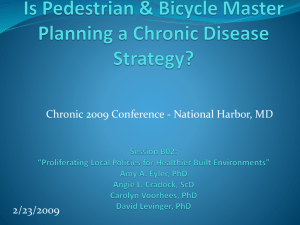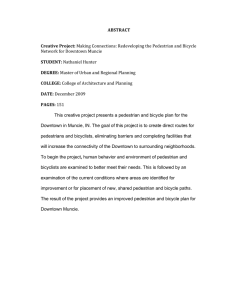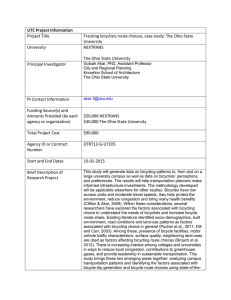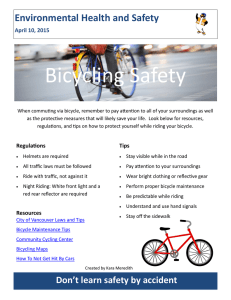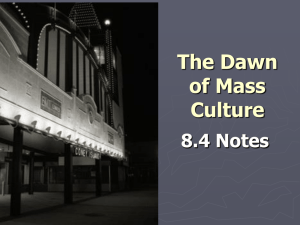chapter 2. vision, goals, and objectives
advertisement
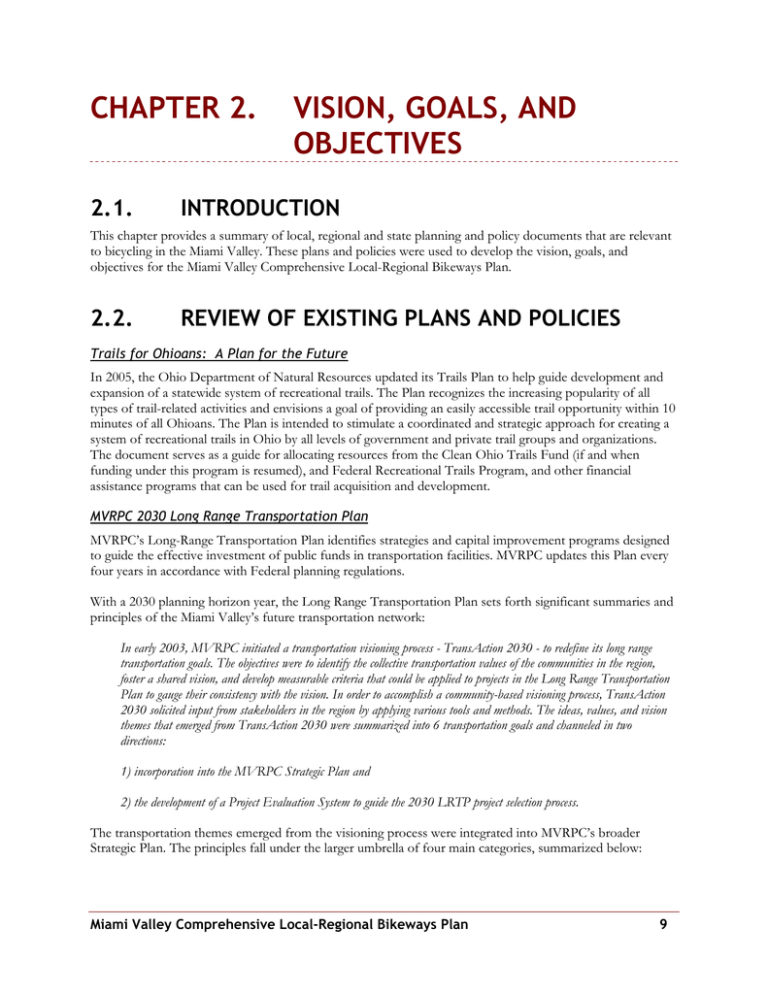
CHAPTER 2. 2.1. VISION, GOALS, AND OBJECTIVES INTRODUCTION This chapter provides a summary of local, regional and state planning and policy documents that are relevant to bicycling in the Miami Valley. These plans and policies were used to develop the vision, goals, and objectives for the Miami Valley Comprehensive Local-Regional Bikeways Plan. 2.2. REVIEW OF EXISTING PLANS AND POLICIES Trails for Ohioans: A Plan for the Future In 2005, the Ohio Department of Natural Resources updated its Trails Plan to help guide development and expansion of a statewide system of recreational trails. The Plan recognizes the increasing popularity of all types of trail-related activities and envisions a goal of providing an easily accessible trail opportunity within 10 minutes of all Ohioans. The Plan is intended to stimulate a coordinated and strategic approach for creating a system of recreational trails in Ohio by all levels of government and private trail groups and organizations. The document serves as a guide for allocating resources from the Clean Ohio Trails Fund (if and when funding under this program is resumed), and Federal Recreational Trails Program, and other financial assistance programs that can be used for trail acquisition and development. MVRPC 2030 Long Range Transportation Plan MVRPC’s Long-Range Transportation Plan identifies strategies and capital improvement programs designed to guide the effective investment of public funds in transportation facilities. MVRPC updates this Plan every four years in accordance with Federal planning regulations. With a 2030 planning horizon year, the Long Range Transportation Plan sets forth significant summaries and principles of the Miami Valley’s future transportation network: In early 2003, MVRPC initiated a transportation visioning process - TransAction 2030 - to redefine its long range transportation goals. The objectives were to identify the collective transportation values of the communities in the region, foster a shared vision, and develop measurable criteria that could be applied to projects in the Long Range Transportation Plan to gauge their consistency with the vision. In order to accomplish a community-based visioning process, TransAction 2030 solicited input from stakeholders in the region by applying various tools and methods. The ideas, values, and vision themes that emerged from TransAction 2030 were summarized into 6 transportation goals and channeled in two directions: 1) incorporation into the MVRPC Strategic Plan and 2) the development of a Project Evaluation System to guide the 2030 LRTP project selection process. The transportation themes emerged from the visioning process were integrated into MVRPC’s broader Strategic Plan. The principles fall under the larger umbrella of four main categories, summarized below: Miami Valley Comprehensive Local-Regional Bikeways Plan 9 Regional Stewardship • Develop Regional Priorities – Continue to address regional transportation needs that further the shared social, economic, and environmental goals of the region through improved planning Vibrant Communities • Transportation Choices – Encourage a stronger multi-modal network in the region to ensure that people and goods reach their destination safely, efficiently, and conveniently • Transportation System Management – Continue to maintain and upgrade the regional transportation system by providing safety, aesthetics, and capacity improvements as needed • Transportation and Land Use – Incorporate regional land use strategies into the transportation policy and the investment decision making process Vigorous Economy • Transportation – Continue to address regional transportation needs in order to support existing businesses and to enhance the region’s attractiveness for future economic development opportunities Healthy Environment • Clean Air – Encourage the pursuit of alternative fuels to reduce emissions and our reliance on petroleum-based products Transportation Improvement Program MVRPC’s 2008-2011 Transportation Improvement Program (TIP) is a four-year capital improvement program of highway, bikeway and transit projects that ensures coordination between the urban transportation planning process and projects utilizing Federal funds. Serving as an implementation tool of the Long Range Transportation Plan, the TIP provides a more detailed transportation capital improvement program and is updated every two years. The TIP lists specific projects for Greene, Miami, Montgomery, and Northern Warren counties. It also guides implementation of the Long Range Transportation Plan. Specific TIP bikeway projects are discussed in Chapter 5 of this Plan. Local Bikeway Plans Several communities within the MVRPC planning area have completed bikeway plans outlining strategies for local improvements. The City of Beavercreek’s Bikeway Plan depicts a 20-year priority plan for bikeways and walkways. Developed by the Beavercreek Planning and Zoning Department and approved by City Council in 1999, the Plan states that all arterial streets should eventually include bikeways and walkways. The Centerville-Washington Township Park District jointly completed the Community Connections Plan in 2005. The Plan lays out a long-range system of on- and off-street bikeways, with each agency responsible for implementing projects within their respective areas. The Xenia Comprehensive Recreation Plan was jointly completed by the City of Xenia and Greene County. The Plan lays out a system of on- and off-street bikeways connecting Xenia with the surrounding trail system. 2.3. NEW VISION, POLICY, GOALS AND OBJECTIVES This section presents the recommended Comprehensive Local-Regional Bikeways Plan vision, policy, goals and objectives. These recommendations are based on the foundation established in MVRPC’s past planning efforts, and were also informed by models from other communities. This Plan also encourages communities within the MVRPC planning area to update their local goals, objectives, and policies as a means for fulfilling 10 Miami Valley Comprehensive Local-Regional Bikeways Plan local elements of this Plan. Updating local zoning ordinances and development codes also represent a concrete means for implementing this Plan. 2.3.1. Plan Vision The overall vision of the Comprehensive Local-Regional Bikeways Plan is as follows: “The Miami Valley Regional Planning Commission’s Comprehensive Local-Regional Bikeways Plan is intended to enhance region-wide bikeway networks including both regional and local bike paths and their connections through the MVRPC planning area.” 2.3.2. Proposed Goals and Objectives With a broad approach to infrastructure and education, there are a range of Goals and Objectives that can be developed to implement the Bikeways Plan. In successful bicycling regions (e.g., Chicago, Portland, Amsterdam and others), each goal has specific timeframes and targets for measuring success. The following goals and objectives will help MVRPC guide the implementation process for the Bikeways Plan and provide measurable benchmarks that are part of the agency’s management processes. Chapter 8 also discusses the concept of using benchmarks for measuring progress. Goal 1: Implement the Miami Valley Comprehensive Local-Regional Bikeways Plan. Objective 1-1: Complete the proposed Top-Priority projects identified in the Bikeways Plan in the next ten years. Benchmarks: Miles of projects completed; number of locations improved; number of bike parking spaces installed; percentage of projects completed. Objective 1-2: Complete the proposed High-Priority projects system within the next 20 years. Benchmarks: Miles of projects completed; number of locations improved. Goal 2: Increase the number of people bicycling for transportation and recreation. Objective 2-1: Increase the mode share of trips made by bicycling in the Miami Valley to five percent of all trips in ten years. Objective 2-2: Increase the number of bikeway system users by five percent per year as measured through annual count data. Benchmarks: Conduct annual counts of pedestrian and bicycle travel at key locations on the on- and off-street bikeway system using the National Bicycle and Pedestrian Documentation Project methodology; number of bicycle-on-bus trips: utilize U.S. Census data for mode share data. Goal 3: Improve bicyclist safety. Objective 3-1: Reduce the number of bicyclist injuries and fatalities by ten percent, and maintain a crash rate consistent with the region’s population. Benchmark: Annual crash data reports. These broad goals can be supplemented by specific actions that integrate bicycling with other initiatives and programs, including the following: Miami Valley Comprehensive Local-Regional Bikeways Plan 11 Goal 4 (Green Goal): Make bicycling a major focus of the Miami Valley region’s efforts to create energy independence. As climate change becomes a major issue in the national media, local communities are realizing the role that non-motorized transportation can play in reducing energy use and dependence on fossil fuels. “Carbon Neutral” planning has become one of the tools for documenting pollution reductions that communities can make as a response to creating sustainable solutions. The performance benchmark for environmental quality is an annual calculation of the pollution reduction benefits achieved by bicycle travel in the Miami Valley. Goal 5 (Health Goal): Improve the health and physical fitness of Miami Valley residents. Each trip by bicycle, for either transportation or recreation, results in increased physical activity and related improvements in cardiovascular fitness. A calculation of the number of calories used by cyclists can be tracked annually and benchmarked against local health data for obesity, cardiovascular disease and diabetes. Goal 6 (Education, Encouragement and Enforcement Goal): Bicyclists, pedestrians, and motorists will share the road safely. Emphasize education, encouragement and enforcement that parallel the development of physical infrastructure. Specific benchmarks include the percentage of motorists obeying cyclists’ rights-of-way, surveys of legal bicyclist behavior (e.g., riding with traffic, wearing helmets, using night lighting), participation in cycling events (e.g., National Bike Month, races and club rides) and programs (e.g., number of League of American Bicyclists Certified Instructors, Bicycle Friendly Communities designation, number of cyclists trained in Effective Cycling, police on bikes, recycle-a-bicycle, bicycle registration, etc.). Goal 7 (Economic Goal): Capitalize on the benefits of bicycling in the local economy. Promote bicycling in economic development, tourism and job creation programs. Identify business benefits including employee health and quality of life. Benchmarks include bicycle related tourism (events, lodging, meals, etc), job creation and retail activity. Goal 8 (Safe Routes to Schools Goal): Involve Miami Valley schools in Safe Routes to Schools Programs. The growing national Safe Routes to Schools (SR2S) programs provide multiple benefits for health, safety, mobility and the environment. Specific benchmarks include the percentage of schools with active SR2S programs and the mode share of children bicycling to school. Chapter 7 of this Plan provides a detailed Safe Routes to Schools “Toolkit” for use by school districts in the Miami Valley Region. Goal 9 (Support Facilities Goal): Encourage and assist local communities in the Miami Valley region to provide appropriate bicycle support facilities. MVRPC should assist local agencies in developing bicycle parking and other support facilities ordinances. The Pedestrian and Bicycle Information Center and the Association of Pedestrian and Bicycle Professionals provide sample bicycle parking ordinances, addressing both short- and long-term parking facilities. The benchmark for this goal will include the number of bicycle parking spaces installed annually. Goal 10 (Quality of Service Goal): Ensure that the Miami Valley region’s bikeways are well maintained and operated. As the bikeway system is expanded over time, it requires an on-going operations and management program. Operations include safety patrols, security, activity programming, promotional efforts, education and outreach, routine litter patrol, annual safety reporting, and facilities condition management. A thorough management process could include an annual reporting program, assignment of staff responsibilities, interagency coordination, and the development of public-private partnerships. The benchmark can be an 12 Miami Valley Comprehensive Local-Regional Bikeways Plan annual report developed by MVRPC and partner agencies summarizing operations and maintenance needs as well as measures taken to address these needs. 2.4. REVIEW OF RELEVANT LEGISLATION The following sections provide an overview of Federal, State and local legislation relating to the Miami Valley Comprehensive Local-Regional Bikeways Plan. 2.4.1. SAFETEA-LU In the United States, Federal transportation legislation has played a key role in the development of bikeways. On August 10, 2005, the Safe Accountable, Flexible, Efficient Transportation Equity Act – A Legacy for Users (SAFETEA-LU) was signed. The new legislation updates Titles 23 and 49 of the United States Code (U.S.C.) and builds on significant changes made to Federal transportation policy and programs by the 1991 Intermodal Surface Transportation Efficiency Act (ISTEA) and the 1998 Transportation Equity Act for the 21st Century (TEA-21). Under SAFETEA-LU, funding for bicycle and pedestrian facilities and programs has exceeded $400 million per year, a level that is far beyond the $4 million per year the U.S. provided prior to ISTEA. Significant new funding streams include the Safe Routes to Schools program, the Model Communities program, and renewed support for the Transportation Enhancements program. The SAFETEA-LU legislation has a number of provisions that relate to improving bicycling and walking conditions and increasing the safety of the two modes. The following summary is provided by USDOT: Policy: Mainstreaming Non-motorized Transportation “Federal transportation policy is to increase nonmotorized transportation to at least 15 percent of all trips and to simultaneously reduce the number of nonmotorized users killed or injured in traffic crashes by at least 10 percent. This policy, which was adopted in 1994 as part of the National Bicycling and Walking Study, remains a high priority for the U.S. Department of Transportation (DOT). SAFETEA-LU continues to provide the funding opportunities, planning processes, and policy language by which States and metropolitan areas can achieve this ambitious national goal. Improving conditions and safety for bicycling and walking embodies the spirit and intent of ISTEA, TEA-21, and SAFETEA-LU to create an integrated, intermodal transportation system which provides travelers with a real choice of transportation modes. State and local agencies are challenged to work together cooperatively with transportation providers, user groups, and the public to develop plans, programs, and projects which reflect this vision. At the Federal level, the Federal Highway Administration (FHWA) is working with the National Highway Traffic Safety Administration (NHTSA), the Federal Transit Administration (FTA), the Federal Railroad Administration (FRA), and other agencies, to implement the bicycle and pedestrian provisions of SAFETEA-LU. This guidance document provides additional information on this important subject. SAFETEA-LU confirms and continues the principle that the safe accommodation of nonmotorized users shall be considered during the planning, development, and construction of all Federal-aid transportation projects and programs. To varying extents, bicyclists and pedestrians will be present on all highways and transportation facilities where they are permitted and it is clearly the intent of SAFETEA-LU that all new and improved transportation facilities be planned, designed, and constructed with this fact in mind. • The long range metropolitan and Statewide transportation plans, and the Metropolitan and Statewide Transportation Improvement Programs shall "provide for the development and integrated management and operation of transportation facilities (including accessible pedestrian walkways and bicycle transportation facilities) that will function as an intermodal transportation system... (23 U.S.C 134(c)(2) and 135(a)(2)) Miami Valley Comprehensive Local-Regional Bikeways Plan 13 • The process in developing the long-range Statewide and metropolitan transportation plans and transportation improvement plans is to consider "...all modes of transportation..." (23 U.S.C.134(c)(3) and 135(a)(3) • The long-range metropolitan and Statewide transportation plans are to "provide for the development and implementation of the intermodal transportation system" (23 U.S.C. 134(i)(2) and 135(f)(1) • SAFETEA-LU added "representatives of users of pedestrian walkways and bicycle transportation facilities" to the list of ‘interested parties" with whom metropolitan areas and States must include in the development of the long range metropolitan and Statewide transportation plan (23 U.S.C 134(i)(5) and 135 (f)(3)(A) • Bicyclists and pedestrians shall be given due consideration in the comprehensive transportation plans developed by each metropolitan planning organization and State..." (23 U.S.C. 217(g)(1) • "Bicycle transportation facilities and pedestrian walkways shall be considered, where appropriate, in conjunction with all new construction and reconstruction and transportation facilities, except where bicycle and pedestrian use are not permitted." (23 U.S.C. 217(g)(1) • "Transportation plans and projects shall provide due consideration for safety and contiguous routes for bicyclists and pedestrians." (23 U.S.C. 217(g)(2) • "In any case where a highway bridge deck is being replaced or rehabilitated with Federal financial participation, and bicyclists are permitted on facilities at or near each end of such bridge, and the safe accommodation of bicyclists can be provided at reasonable cost as part of such replacement or rehabilitation, then such bridge shall be so replaced or rehabilitated as to provide such safe accommodations." (23 U.S.C. Section 217(e)) • "The Secretary shall not approve any project or take any regulatory action under this title that will result in the severance of an existing major route or have significant adverse impact on the safety for nonmotorized transportation traffic and light motorcycles, unless such project or regulatory action provides for a reasonable alternate route or such a route exists." (23 U.S.C. Section 109(m)) While these sections stop short of requiring specific bicycle and pedestrian accommodation in every transportation project, Congress clearly intends for bicyclists and pedestrians to have safe, convenient access to the transportation system and sees every transportation improvement as an opportunity to enhance the safety and convenience of the two modes. "Due consideration" of bicycle and pedestrian needs should include, at a minimum, a presumption that bicyclists and pedestrians will be accommodated in the design of new and improved transportation facilities. In the planning, design, and operation of transportation facilities, bicyclists and pedestrians should be included as a matter of routine, and the decision to not accommodate them should be the exception rather than the rule. There must be exceptional circumstances for denying bicycle and pedestrian access either by prohibition or by designing highways that are incompatible with safe, convenient walking and bicycling. TEA-21 required FHWA to undertake a design study to "develop guidance on the various approaches to accommodating bicycles and pedestrian travel" and to report back to Congress by December 9, 1999. The guidance clarified those "exceptional circumstances" where bicyclists and pedestrians may not be accommodated. This Design Guidance language can be found at http://www.fhwa.dot.gov/environment/bikeped/design.htm. Separate supplementary guidance to clarify a number of issues in the original design guidance can be found at http://www.fhwa.dot.gov/environment/bikeped/supdesgn.htm. Even where circumstances are exceptional and bicycle use and walking are either prohibited or made incompatible, States, MPOs, and local governments must still ensure that bicycle and pedestrian access along the corridor served by the new or improved facility is not made more difficult or impossible. For example, there may be ways to provide alternate routes on parallel surface streets that are still safe and convenient, or to provide shuttle bus service on major bridge crossings. Maintaining access to the transportation system for nonmotorized users is not an optional activity. Section 109(m) of Title 23, United State Code, states that "The Secretary shall not approve any project or take any regulatory action under this title that will result in the severance of an existing major route or have significant adverse impact on the safety for nonmotorized transportation 14 Miami Valley Comprehensive Local-Regional Bikeways Plan traffic and light motorcycles, unless such project or regulatory action provides for a reasonable alternate route or such a route exists." Bicyclists and pedestrians have the same origins and destinations as other transportation system users and it is important for them to have safe and convenient access to airports, ports, ferry services, transit terminals, and other intermodal facilities as well as to jobs, services, recreation facilities, and neighborhoods. SAFETEA-LU places a strong emphasis on creating a seamless transportation system that all users can enjoy and use efficiently and safely.” Source: http://www.fhwa.dot.gov/environment/bikeped/bp-guid.htm 2.4.2. Ohio Legislation Through the successful advocacy efforts of the Ohio Bicycle Federation (OBF), a “Bill for Better Bicycling in Ohio - House Bill 389” was recently adopted. HB 389 was signed into law during the 2006 GOBA opening ceremonies at the Greene County Fairgrounds in Xenia. The OBF provides the following summary of the new law: “The Better Bicycling in Ohio bill, known as House Bill 389, makes Ohio laws regarding cycling conform more closely aligned with the Uniform Vehicle Code (UVC). The OBF worked for years as a member of the National Committee on Uniform Traffic Laws and Ordinances to make the UVC more cyclist friendly. Now, Ohio law will follow the UVC. The new laws will: Substitute "far enough to the right to allow passing by faster vehicles if such passing is safe and reasonable" for "as close as practicable to the right-hand curb" in the "slow-moving vehicle" section of the Ohio Revised Code. No longer require front and rear wheel reflectors if a red light is used in the rear. Permit generator-powered lights. Permit either flashing or steady rear light. No longer require a bell or horn.” Source: http://www.ohiobike.org/hb389info.html In addition to the new legislation, the OBF also provides a summary of Ohio legislation relevant to bicycling. The summary includes the following sections: 2.4.3. § 4501.01. Definitions. As used in this chapter and Chapters 4503., 4505., 4507., 4509., 4511.,4513., 4515., and 4517. of the Revised Code, and in the penal laws, except as otherwise provided: "Vehicle" means every device, including a motorized bicycle, in, upon, or by which any person or property may be transported or drawn upon a highway, except that "vehicle" does not include any motorized wheelchair, any electric personal assistive mobility device, any device that is moved by power collected from overhead electric trolley wires or that is used exclusively upon stationary rails or tracks, or any device, other than a bicycle, that is moved by human power. Comment: A bicycle is defined as a vehicle and thus is governed by a uniform set of rules common to all vehicles and a small set of specific rules for bicycles. (There are other specific rules for other vehicle types, such as trucks or busses.) The annotated list here summarizes the most important parts of the traffic rules Miami Valley Comprehensive Local-Regional Bikeways Plan 15 and equipment rules that govern bicycle driving. People who try to make up their own rules have an accident rate five times higher than knowledgeable cyclists who follow the rules of the road. 2.4.4. § 4511.07. Local traffic regulations. (A) Sections 4511.01 to 4511.78, 4511.99, and 4513.01 to 4513.37 of the Revised Code do not prevent local authorities from carrying out the following activities with respect to streets and highways under their jurisdiction and within the reasonable exercise of the police power: (8) Regulating the operation of bicycles: provided that no such regulation shall be fundamentally inconsistent with the uniform rules of the road prescribed by this chapter and that no such regulation shall prohibit the use of bicycles on any public street or highway except as provided in section 4511.051 of the Revised Code; (9) Requiring the registration and licensing of bicycles, including the requirement of a registration fee for residents of the local authority; (B) No ordinance or regulation enacted under division (A)(4), (5), (6), (7), (8), or (10) of this section shall be effective until signs giving notice of the local traffic regulations are posted upon or at the entrance to the highway or part of the highway affected, as may be most appropriate. Comment: The most important of the reforms passed in 2006 will require that any local regulations be consistent with the uniform rules of the road. In addition, signs are required of such local regulations. Unfortunately, there are still many ordinances inconsistent with uniform laws. Some of these bad ordinances mandate unsafe practices. Source: http://www.ohiobike.org/bicycle-law-digest.html 2.5. CONCLUSION This policy, goals and legislation review will provide a framework for the Miami Valley Comprehensive LocalRegional Bikeways Plan. As the local and regional bikeway system evolves beyond a network of trails into a network of both on- and off-street improvements, this comprehensive approach will lead to improved mobility, safety, health and quality of life. 16 Miami Valley Comprehensive Local-Regional Bikeways Plan
